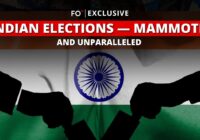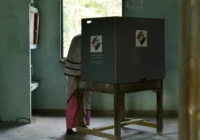Many say that, in a democracy, the people get the government they deserve. This is not true if the political system subverts the people’s will or if it misleads or misinforms them. What if actors can manipulate the election process? What if only one side gets all the resources to campaign and fights elections by tilting the playing field? Both these problems have manifested in India, and it is unlikely they can be resolved without the intervention of the Supreme Court of India (SCI).
The Varieties of Democracy Institute now classifies India as an “electoral autocracy.” India may very soon turn into a sham democracy or a total dictatorship, very far from the “mother of democracy” boast of Prime Minister Narendra Modi.
There are three main issues with India’s elections. The first is the way citizens cast votes at the ballot box. The current system is flawed and vulnerable. The second is campaign funding. There is little or no transparency, and spending is exorbitant. The third issue is the voting system itself — the first-past-the-post system. This system creates unrepresentative outcomes. Given the circumstances, only the SCI can remedy the situation. The fate of Indian democracy depends upon it.
Potential corruption with the voting method
India’s 18th parliamentary elections are ongoing. Voting started on April 19 and will end on June 1. The official results will be announced three days later on June 4. The Election Commission of India (ECI) is operating around 1.2 million polling booths across 543 parliamentary constituencies, with 960 million eligible voters. In the last general elections in 2019, 669 political parties and 3,469 independent candidates contested. This year is even bigger. It is a truly monumental undertaking.
The ECI uses Electronic Voting Machines (EVMs) which its own experts have hyped as the “global gold standard.” This system makes announcing the results much faster than manual counting. Results are available within just one day. However, the EVM system uses obsolete, vulnerable technology and requires millions of staff to function.
An EVM is made up of three devices: the control unit (CU), the voter-verifiable paper audit trail (VVPAT) and the ballot unit (BU). A polling officer will have the CU in front of them and when the voter is ready to vote, they will activate it. This allows the voter to press a button on the BU and register their vote. The VVPAT’s viewing window then lights up for seven seconds, displaying the printed vote, with the candidate’s name and symbol, for the voter to check that it is correct. The VVPAT then cuts the slip off and deposits it into the ballot box.
The ECI has made many claims about the EVMs’ functionality, but these claims are under fire from experts. Kannan Gopinathan, previously a member of the Indian Administrative Service and a Returning Officer (someone who is in charge of conducting elections in a district), is one of these critics. The ECI claims that EVMs are standalone systems, not connected to the Internet. It also says that they are designed to be programmed only once and cannot be reprogrammed. Gopinathan rejects both of these claims.
On the ECI website’s FAQ and presentation pages are details for how EVMs work. These show that the VVPAT machines contain programmable memory and that additional devices are needed for the EVMs to function.
In actuality, the District Election Officer in each constituency connects a laptop, via the Internet, to the ECI’s central server to download the candidate data file. The officer then copies the file into data drives called Symbol Loading Units (SLU). Field staff then take these SLUs to connect them to the VVPAT of the EVM in each election booth for “commissioning” the EVM. Thus, the system is exposed, albeit indirectly, to the Internet. Further, if field staff can connect an external device to the EVM, then, in principle, anyone could.
Whether through the Internet or physically with a data drive, a malicious person could insert a program and manipulate votes. While the central server may be under the ECI’s watchful guard, the EVMs themselves, distributed throughout the country, along with the laptops and SLUs, are vulnerable. A viral video circulated on social media recently demonstrated how hackers could game an EVM.
Back in 2019, polling stations returned many curious results. In a 2023 paper, economist Sabyasachi Das highlighted the statistical improbabilities of certain results. The ECI summarily negated all claims of irregularities or vulnerabilities on its website. However, it has shied away from answering criticisms like Gopinathan and Das’s in any detail. This raises suspicion that they may be aware the machines are vulnerable.
Although opposition leaders requested meetings with the ECI’s leadership, they were refused.
Opposition to EVM usage has now begun to pick up steam. Organizations such as the Citizens’ Commission on Elections and the Association for Democratic Reforms, among others, have filed petitions against the use of EVMs. Thousands of eminent citizens, including retired SCI judges, retired government secretaries, lawyers, activists and computer science professors have also signed petitions. Unlike the US Supreme Court, the SCI can issue legal decisions on petition without waiting for a lawsuit to come before it. (It may even issue decisions of its own volition, without a petition.) Yet the SCI refused to respond to these petitions for some time. On April 16, 2024 — just three days before voting began — it finally agreed to look at the petitions.
The deliberations took ten days, as the court had to receive some clarifications from the ECI. On April 26 — a full week after the voting had started — they issued their judgment. The SCI dismissed all the petitions and gave directions to the ECI: They must support a post-result audit of the EVMs and SLUs if a second or third-place candidate requests it. The candidate must request it within seven days of the results announcement, and the candidate can only choose a maximum of 5% of the EVMs used in the constituency for auditing.
According to the judgment, engineers are to audit certain parts of the EVMs and not everything. If they conduct the audit properly, they will easily find machines that are still in a compromised state. Thus, the audit will at least have some deterrent value, because low-level hackers are likely to get caught. However, hackers are capable of much more. There are programs that can erase themselves and leave no trace. To auditors, it would seem as though nothing were wrong.
Furthermore, the court ignored multiple other points made by the petitions. Petitioners had asked for introducing manual insertion of the voting slip by the voter and manual counting of the slips. The court made no decision regarding either. Without these fail-safes, there is still a substantial opportunity for hackers to succeed. The petitioners’ requests would have foiled all hacks.
The court’s decision is not the only legal roadblock to voting security. Current electoral law even makes it difficult for voters themselves to correct errors. If an EVM is hacked and behaves erratically, it may not print the correct vote for the voter. A voter can make an official complaint at the time and have an officer check the machine, but the voter then has to replicate the error. If the error is not replicable, then the voter can face a fine or even jail time. Someone manipulating an EVM can easily make it seem like everything is fine and then proceed after an officer has checked the machine, none the wiser.
Four changes would fix these issues:
- Allowing the voter to pick up the VVPAT printed slip for verification and physically insert it into the ballot box. Alternatively, the VVPAT window should be lit up long enough for the voter to see the slip drop into the ballot box. This way, voters can verify that the paper is correct and know themselves that they inserted it into the ballot box.
- Basing election results on a manual count of paper slips. In case of discrepancy between the manual count and the CU count, up to two recounts should occur. The manual count should prevail and not the CU count.
- Disallowing the transportation of the CU and the ballot box together to the counting station. Transporting them separately ensures that the votes cast are safer from manipulation.
- Ending the punishment for being unable to prove an error occurred when a voter makes a complaint.
Implementation of these will aid in making the process fairer for all.
There is another way, though. India has the necessary digital public infrastructure to conduct online elections for a fraction of the time and cost. An online voting system would be many times cheaper, safer and more efficient than using EVMs. A smartphone app could replace EVMs, allowing citizens to vote from anywhere.
Modi is pushing for a “One Nation, One Election” reform, aiming to hold all elections either on a single day or at least over a shorter time frame. This will supposedly save both time and money, but an online voting system can save far more of both. Unfortunately, the opposition parties have not advocated for any sort of change either, leaving Modi and his government unopposed.
The pernicious political funding problem
Parties spent an estimated $8.6 billion on campaigning in 2019. The 2024 general elections are projected to cost $16.2 billion, which would make them the costliest in the world. Experts estimate that the Bharatiya Janata Party (BJP), the current ruling party, outspent all the other parties put together in 2019. This skew will likely be greater in 2024.
We can judge the relative amounts of money the BJP and other parties are able to mobilize by looking at the portion of their fundraising that qualifies as legally obtained “white money.” The BJP was able to mobilize large sums by means of electoral bonds (EBs). These financial instruments allowed donors to give money to parties legally and anonymously. Still, illegal black money vastly exceeds the amount of white money. Every party mobilizes and spends five to ten times as much black money as white money.
There is little or no transparency in political funding. It has always been fraught with quid pro quo. Parties habitually take funding from private firms and promise them government contracts in exchange. It has emerged that the Modi government, additionally, uses extortion by deploying multiple investigative agencies and tax authorities that it controls.
The SCI recently ruled EBs to be unconstitutional. It found that the bonds’ anonymity violated citizens’ right to know who is funding their political parties. The high court also forced the State Bank of India and the ECI to publish all details of EBs purchased by donors and deposited by political parties. The disclosures reveal that the BJP obtained the lion’s share of bonds. These ran into billions of dollars, and the contracts they awarded to donors ran into hundreds of billions of dollars. The disclosures also revealed the roles of so-called “independent institutions” who all participated in quid pro quo.
The ECI should mandate 100% disclosure of all funds mobilized by every candidate and every political party. In today’s world, this is easy. The party, individual candidate or the ECI should publish data on their respective website or on an ECI-provided platform. The minimum data provided should be the name of the donor, their identifier, the amount and the date.
Currently, parties need not disclose donations below 20,000 rupees ($240), they exploit this loophole. One party claimed that nearly all of its funding came from smaller donations. Requiring full disclosure would close this loophole.
Furthermore, the ECI should remove their imposed expense caps which apply to candidates. The expense caps are currently so low — 9.5 million rupees ($114,000) — that all candidates are forced to tell lies. They must spend much more money than the law allows, because those who do not have black money tend to lose. The existing system reduces the chances of honest and smart candidates winning elections and it rewards those who have a lot of black money and who can manipulate the system to get others to spend on their behalf via quid pro quo.
One excellent way to remove parties’ incentive to use black money would be the state providing free airtime on its TV channels — both national and regional — to all candidates. Thus every party could be sure that it is getting enough airtime for its views.
The state could also arrange debates between the leading three or four candidates so that voters know the candidates better before they vote. The candidates could select the moderators themselves. The recorded debates and statements could be available on the ECI’s portal after each debate aired. Citizens could make more informed decisions, and the candidates would be more accountable because citizens can recall their statements and compare their accomplishments.
The voting system is unrepresentative
Even if hacking and corruption do not taint the votes, the way that votes are used to allocate seats in parliament is itself problematic.
India uses the first-past-the-post system to decide who wins each seat. The plurality winner in each district gets the seat, even if the winner does not achieve an absolute majority. The winner might thus have only the support of a small fraction of the community. The rest of the voters, even if they are the majority, go unrepresented.
In the 2019 elections, 67% of the 900 million eligible voters voted. The BJP pulled the largest share of votes, but not a majority. They received 37.4% of the votes, yet they bagged 55.8% of the seats (303 out of 543) in the lower house of parliament, giving them an absolute majority.
A two-round system would ensure that the ultimate winner has the support of at least 50% of voters. In the first round, all qualified candidates would compete; then, the top two candidates would face each other in a runoff election. The winner of the runoff will not always be the same as the candidate who got the most votes in an open competition since many voters will switch to a second-best candidate if their preferred candidate does not win the first round. As an illustration, a supporter of party A may decide to vote for party B in the second round. Without a runoff, party A and party B may have split the vote between them, allowing the party C candidate to win — even if the majority of voters in that constituency would have preferred that the party C candidate not win.
India uses the runoff elections for the president and vice president, but not for members of parliament or state legislatures. With the runoff voting, opposition parties with similar ideologies — or at least those who share a rejection of the ruling party’s ideology — would fare better. If India had had two-round voting in 2019, opposition parties would have won the majority of the seats in parliament, representing 62.6% of voters rather than a mere 37.4%.
Changing voting systems would ensure a far more representative democracy in India, with coalitions that better represent the ideological makeup of the country.
As things are going, India is going down the path towards authoritarianism. The mother of democracy should not give birth to an autocratic regime. The reforms discussed would make India a truly fair democracy.
[Will Sherriff edited this piece.]
The views expressed in this article are the author’s own and do not necessarily reflect Fair Observer’s editorial policy.
Support Fair Observer
We rely on your support for our independence, diversity and quality.
For more than 10 years, Fair Observer has been free, fair and independent. No billionaire owns us, no advertisers control us. We are a reader-supported nonprofit. Unlike many other publications, we keep our content free for readers regardless of where they live or whether they can afford to pay. We have no paywalls and no ads.
In the post-truth era of fake news, echo chambers and filter bubbles, we publish a plurality of perspectives from around the world. Anyone can publish with us, but everyone goes through a rigorous editorial process. So, you get fact-checked, well-reasoned content instead of noise.
We publish 2,500+ voices from 90+ countries. We also conduct education and training programs
on subjects ranging from digital media and journalism to writing and critical thinking. This
doesn’t come cheap. Servers, editors, trainers and web developers cost
money.
Please consider supporting us on a regular basis as a recurring donor or a
sustaining member.
Will you support FO’s journalism?
We rely on your support for our independence, diversity and quality.










Comment